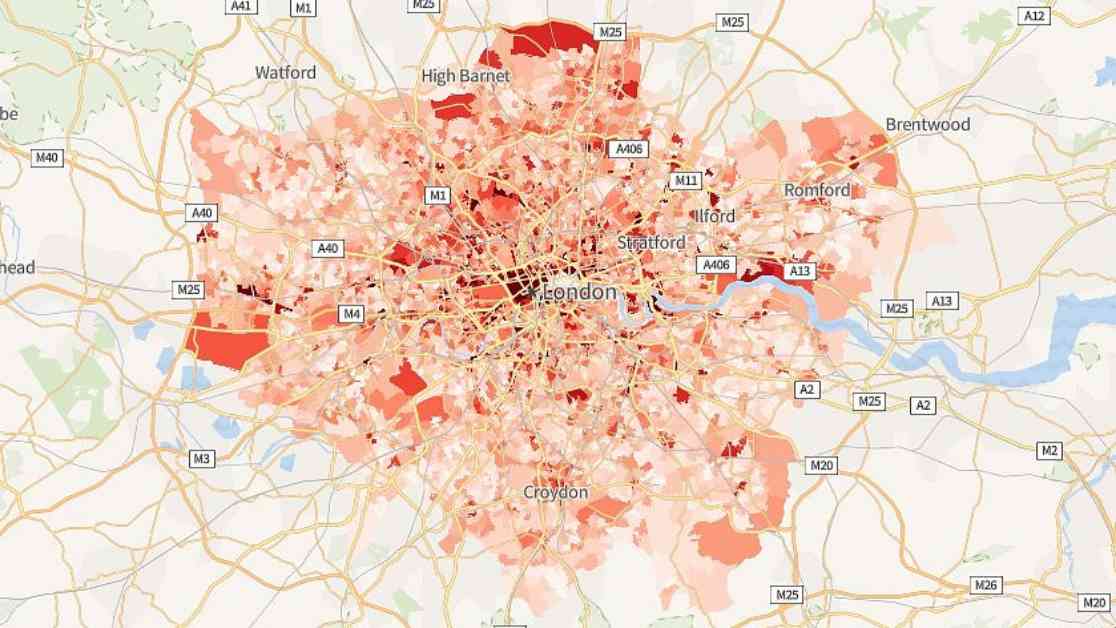The upscale neighborhoods of Mayfair and Soho in London have been identified as the burglary hotspots of England and Wales. A detailed analysis conducted by MailOnline highlighted the area around Regent Street, boasting 282 break-ins in the past year. Despite its small population of 2,280 residents, this particular block, including Oxford Street, New Bond Street, Carnaby Street, and Saville Row, experienced a staggering 123 burglaries per 1,000 individuals.
This comprehensive investigation covered over 37,000 neighborhoods across the two countries, presenting a vivid picture of crime rates through an interactive map. By utilizing official statistics, the analysis categorized crime rates by ‘Lower layer Super Output Areas’ (LSOAs), encompassing small communities of 500 to 1,500 people. Each neighborhood’s offenses were ranked per 1,000 population, allowing a clear view of the high-crime areas. The color-coding on the map, with darker shades of red indicating higher crime rates, offered a user-friendly experience to locate specific regions.
The timing of this report is crucial as the UK battles a crime epidemic, with growing demands for stricter law enforcement to curb the rising rates. Against this backdrop, celebrities like Michelle Keegan and Mark Wright have recently become victims of home invasions. The urgency to address the critical issue of burglary is underscored by these high-profile incidents, emphasizing the need for enhanced security measures and vigilant policing.
The survey findings revealed that the district encompassing Regent Street holds the unenviable title of the burglary capital, highlighting the gravity of the situation in this coveted area. While nearly 2,400 neighborhoods exhibit burglary rates exceeding 10 per 1,000 residents, approximately 6,200 areas boast effectively zero burglary rates. This stark contrast underscores the vast disparities in crime distribution across England and Wales.
Unveiling the second-highest burglary rate, the area surrounding Birmingham New Street station in the West Midlands emerged as a crime-prone location. With 149 burglaries reported in the past year among a population exceeding 1,200, the district faces significant security challenges. Notably, this region was identified as the most crime-ridden neighborhood for violent offenses in the previous week’s analysis, indicating a concerning pattern of criminal activities.
Ranked third in the burglary rate analysis is the City of London, encompassing iconic landmarks like St Paul’s Cathedral and Liverpool Street. Despite a population of around 2,500 residents, the neighborhood witnessed 209 burglaries last year, translating to a rate of 82 per 1,000 individuals. These statistics underscore the pressing need for increased surveillance and preventive strategies to safeguard residents and properties.
The real-life experiences of victims like Michelle Keegan and Mark Wright bring a human touch to the statistics, highlighting the emotional turmoil and trauma inflicted by burglaries. The harrowing accounts of break-ins, as narrated by individuals like Jo O’Farrell, evoke feelings of vulnerability and fear, underscoring the urgent need for robust security measures. The visual evidence captured by home surveillance cameras brings the stark reality of burglaries to the forefront, emphasizing the importance of proactive crime prevention.
Despite the alarming statistics, public confidence in law enforcement to address burglary cases is waning, reflecting a broader sentiment of skepticism. The low rate of solved burglary cases, as reported by the Home Office, raises concerns about the efficacy of current investigative measures. With only six percent of recorded burglaries resulting in charges, there is a pressing need for enhanced police interventions and community engagement to combat this pervasive issue.
In conclusion, the interactive map detailing burglary rates across England and Wales serves as a wake-up call to authorities, residents, and policymakers. The vivid portrayal of crime hotspots underscores the urgency of implementing targeted interventions, fostering community vigilance, and enhancing security infrastructure to deter criminal activities. By shedding light on the prevalence of burglaries and their far-reaching impact, this analysis underscores the imperative of collective action to safeguard communities and ensure public safety.









